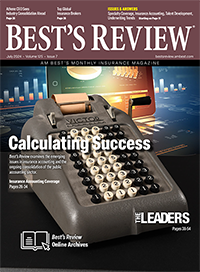The Ins and Outs of Reinsurance Commutations
What to consider when cedents and reinsurers unwind their relationship.
- TBA - Writer
- November 2012
-





Cedants have many things to consider when reviewing their unique reasons for entering into a reinsurance commutation and what may be achieved out of a reinsurance commutation.
All reinsurance commutations will be different. While some may be mandatory or prescribed in the reinsurance contract, most will be negotiated many years after the reinsurance contract was drafted and agreed to. Therefore, many commutations will represent noncontractual agreements that need to be negotiated with each and every reinsurer participating on the contract.
The agreements reached could differ with each participating reinsurer on any reinsurance contract. Thus, cedants should be prepared to accept partial commutations on particular reinsurance treaties where agreements cannot be reached with all reinsurers.
Reasons for entering into a reinsurance commutation will vary by cedant but will usually have one or more of the following motivations:
1. A reinsurer is in financial difficulty and receives a rating downgrade or represents an undue level of credit risk to the cedant.
2. Departure by a reinsurer from the class of business reinsured, leading to transactional difficulties.
3. Disagreements over claim recoveries, collateralization and sliding scale ceding commissions and the like.
4. To remove frictional and transactional costs associated with the reinsurance. A great example of a frictional cost is the loss load on many retrospectively rated reinsurance contracts.
5. To take advantage of a discount or reduction in the reinsurance premium.
6. To return ceded premiums to the cedant's balance sheet. Retrospectively, rated reinsurance contracts provide a great example of how a reinsurance commutation can expeditiously reduce the provisional premium down to the minimum premium (or lower) for good experience.
7. A difference in opinion as to the ultimate value of subject claims, whereby the cedant can receive a commutation amount from a reinsurer in excess of their valuation of such claims.
8. A cedant may simply be motivated by desire to avoid administrative efforts or as a part of a long-term strategy.
Where reinsurance contracts provide a retrospective adjustment feature, such as a swing-rated premium or a sliding scale ceding commission, the reinsurance commutation should represent a much simpler negotiation provided the loss experience is within the adjustment features--that is, the reinsurers' margin is not compromised.
Where the reinsurers' margin is compromised the cedant will want to establish, with the greatest certainty possible, the ultimate value of subject losses exposing the reinsurer. Examples of scenarios where a reinsurer's margin has been compromised will include where premium adjustments in a swing plan have exceeded the maximum premium, or a sliding-scale ceding commission has been adjusted down to its minimum level.
Reinsurance treaties exposed to Incurred But Not Reported losses, as well as Incurred But Not Enough losses, will also need ceded IBNR/IBNE to be estimated. A thorough analysis may be required by the cedant's actuaries and must ultimately be supported by the cedant's management. Such analysis may include a range of ultimate loss scenarios exposing the reinsurance treaty.
The analysis should be reconciled against the historical reinsurance accounting of paid and reserved reinsurance recoveries. Where retrospective adjustment features appear in the reinsurance contract the analysis needs to estimate the ultimate value of any loss sensitive premium, commission or other adjustments payable to the reinsurer, in order to determine the ultimate commutation amount payable for the expected ultimate losses.
Given the complexity in trying to establish an ultimate value, the key to negotiating reinsurance commutations with reinsurers is transparency in the analysis. The analysis should allow reinsurers to review any component or assumption employed and obtain granularity all the way back to an individual claim, should it be required. Reinsurers will use their own reserve estimates, use their own assumptions and methodologies, and focus on issues from their own perspective, such as the prevalence of currency risk to international reinsurers, views on hyperinflation or concern of a particular cedant's credit risk.
For these reasons, and to leave room for negotiation of acceptable commutation terms, the cedant should start with a conservative view of their ceded liabilities and their exposure to a particular reinsurer. However, they would be well-advised to maintain reasonableness; otherwise the exercise will quickly be wasted. The analysis should also be versatile and capable of responding to counteroffers as the commutation negotiation develops.
What May Be Achieved
An agreed commutation value will be some form of consideration, usually a final cash settlement, which meets the requirements of the reinsurance contract or, if non-contractual, accomplishes the desire from the cedant and the reinsurer to fully and finally settle and commute all rights, obligations and liabilities, known and unknown, of each other under the terms of the reinsurance contract.
A cedant should only accept a commutation when it satisfactorily covers their expected utility of the reinsurance being commuted. An exception to this rule is the consideration of counterparty credit risk wherein the cedant may be willing to accept less and cut its losses. When evaluating the merits of a specific commutation, the cedant must consider not only their estimate of the ultimate value of the subject claims; it must also consider its exposure to future development on these claims. Releasing reinsurers from liability on subject claims also releases them from any future adverse development on these claims, up to any contractual maximum recoverable amounts. Thus, the cedant should receive compensation for reassuming the potential liability over and above estimated ultimate reserves.
With a full and final reinsurance commutation, the cedant will be giving the reinsurer certainty of its loss experience on that particular contract. Reinsurers generally will look at and act favorably toward reinsurance commutation offers as it allows them to release capital they have committed to support the contract.
An offer for reinsurance commutation often will include a present value factor to represent the time value of obtaining a commutation amount today instead of reinsurance recoveries sometime in the future.
Hindsight is always 20/20. Keep in mind that reinsurers will have incurred their own expenses, capital charges, reinsurance costs and other outlays from contract inception so what seems like a clear level of profit to a reinsurer is not usually the case.
The process of evaluating a commutation is lengthy and can draw considerable costs in resources and time. Therefore it is good to try to establish a level of interest from the other party before proceeding with the due diligence. Additionally, the process of achieving a reinsurance commutation can be positively influenced by how the parties operate and communicate throughout.
Completing a commutation will impact the cedant's balance sheet. Therefore performing a pro forma on the balance sheet will be necessary. For example, should the negotiated commutation value be less than the ceded reserves carried there will be an adverse effect on the cedant's balance sheet. Keeping regulators, rating agencies and stakeholders advised of the commutation is recommended.
Clear and complete documentation of the agreement should accompany the commutation. Key characteristics of commutation documentation should include the establishment of what the consideration shall consist of and a reasonable time line for funds to be exchanged. The documentation should also clearly lay out the provisions of the release of liability ensuring its finality. Special attention should be paid to special provisions within the contracts, such as the treatment of taxes that could reduce a commutation amount upon ultimate receipt.
Finally, commutation can provide a cedant a means to obtain better reinsurance terms or terms that are more suitable to how they wish to obtain recoveries. There are circumstances where commutation can give a reinsurer a degree of certainty before moving forward with a cedant that has had adverse experience.
Post commutation, it is not uncommon for a cedant to consider some alternative forms of reinsurance protection to better reflect the characteristics of a company's liabilities. This is certainly true after a reinsurance commutation (for instance, a cedant may desire some form of adverse loss development coverage or bad faith protection on policies where reinsurance has been commuted). Alternatively, a cedant may wish to obtain reinsurance coverage on a losses-reported basis to bring forward any latent claims.
There are many considerations around reinsurance commutation.
While the subject is likely not prevalent to many reinsurance buyers, it performs a significant role with others.
By Alasdair Roe
(Contributor Alasdair Roe is vice president of the BMS Specialty Casualty Team, based in New York. He can be reached at alasdair.roe@bmsgroup.com)

































